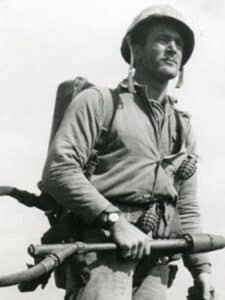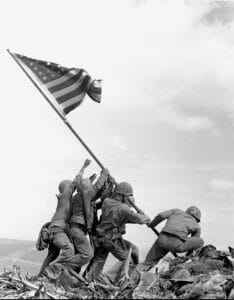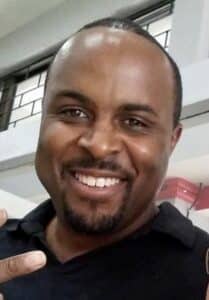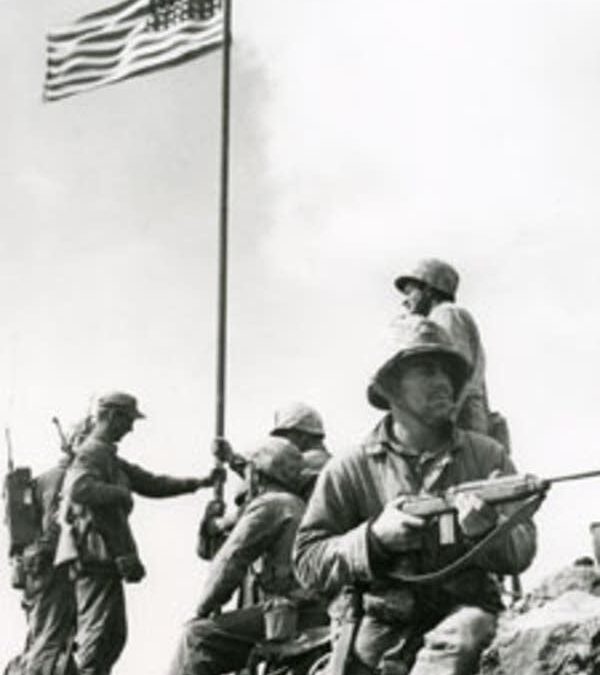First flag raising atop Mt. Suribachi on February 23, 1945. Cpl. Lindberg stands on the right. Photo: Lou Lowery, from the collection of Charles Lindberg.
Today marks the 78th anniversary of the raising of the American flag on Mount Suribachi in Iwo Jima, Japan, February 23rd, 1945.
“Chuck Lindberg won the silver star for bravery for fighting his way to the top of Mount Suribachi in February 1945. He was one of thousands of servicemen fighting the Japanese for control of Iwo Jima. Both sides considered the Pacific island a vital strategic position.
Lindberg and five other Marines made it to the highest peak on Mount Suribachi. He recalled the moment in a 2005 interview with Minnesota Public Radio.
“Two of our men found a great big long pole up there, about 20-feet long. We tied the flag to it, carried it to the highest spot we could find, and raised it. Boy, then the island came alive down below. The troops started to cheer, the ships’ whistles went off, it was quite a proud moment,” he said.

Corporal Charles Lindberg on Mt. Suribachi, Iwo Jima during WWII.
In numerous retellings of that event, Lindberg—who is not related to the trans-Atlantic aviator Charles Lindberg—always emphasized his battalion commander’s instructions to fly the flag not when, but if, the men reached the top of the mountain alive.
The 40 men of Lindberg’s Third Platoon, E Company were among the massive offensive to take control of the island.
“We hit that beach that morning—the 19th of February—and boy did we get a surprise. They mortared us up and down the beach—they had it all synchronized—they could walk ’em right up and down the beach. I found out later their plan was to put us on the beach and annihilate us,” he said.
Lindberg’s group hoisted the flag a good four hours before another group raised a second, larger flag.
AP photographer Joe Rosenthal caught the second flag-raising in a Pulitzer Prize-winning picture that became an icon of American patriotic spirit. In both cases, far from signaling a decisive battle victory, the flags flew at the beginning of a month-long siege that saw the deaths of 6,000 Americans and 20,000 Japanese. Both flags are now on display at the National Museum of the Marine Corps in Quantico, Virginia.
Lindberg made frequent appearances in the 60 years since the war, trying to correct the historical record—and the popular perception—about the first flag to fly on Iwo Jima. His version was not always welcome.
“I was called a liar and everything else. It was terrible,” he said. But Lindberg’s account was confirmed in the book “Flags of our Fathers,” and depicted in the Clint Eastwood film of the same name. Lindberg is the only character portrayed in both “Flags of Our Fathers” and Eastwood’s follow-up film from the Japanese vantage point, “Letters from Iwo Jima.”

Photographer Joe Rosenthal and the 2nd flag-raising photo on Iwo Jima during WWII, which won him a Pulitzer Prize.
“It was the truth. I mean, everyone says, Iwo Jima flag raising, they look at the other one, that’s not right. It wasn’t. That’s what I say. But ain’t good enough, I guess — maybe that’s what they think. Kinda hurts you. But I’ve talked a lot about this, I’ve argued a lot about it. I can always prove it, that’s the thing.”
Lindberg was awarded the Purple Heart after being shot in the arm a week after taking Mount Suribachi.
Lindberg, who grew up in Grand Forks, moved to Richfield with his wife, Vi, in 1953. Last month he was honored in a Memorial Day groundbreaking for a veterans memorial in Richfield. The memorial will feature a likeness of Lindberg carved from Minnesota taconite.
Travis Gorshe is the lead advocate for the memorial. An avid war historian, Gorshe met Lindberg while collecting World War II veterans’ signatures. The two became friends.
“Being a Marine, he was a very proud individual, yet very humble in regards to the time that he served,” according to Gorshe. “The best way to wrap it up is when I talked about making this memorial, the first thing he said was ‘please don’t make it about me, make it about all veterans,'” Gorshe said.” – Art Hughes, MPR News
 Zoe Warren is Editor at Large for The Standard newspaper, a photojournalist, husband, father of three, missionary, musician, filmmaker, documentarian, and storyteller. He is the founder of Pistuo Productions, a narrative film and commercial video production company, the media ministry God’s Plain Truth TV, the Pakistan mission organization Gospel Fire Army, and the studio music project “Striving and Rest.” Warren may be reached at pistuoproductions@gmail.com.
Zoe Warren is Editor at Large for The Standard newspaper, a photojournalist, husband, father of three, missionary, musician, filmmaker, documentarian, and storyteller. He is the founder of Pistuo Productions, a narrative film and commercial video production company, the media ministry God’s Plain Truth TV, the Pakistan mission organization Gospel Fire Army, and the studio music project “Striving and Rest.” Warren may be reached at pistuoproductions@gmail.com.Please “like”, comment, share with a friend, and donate to support The Standard on this page. Become a Patron!




 RSS - Posts
RSS - Posts